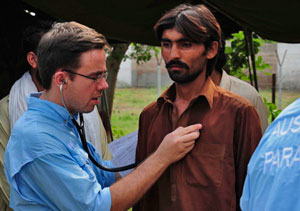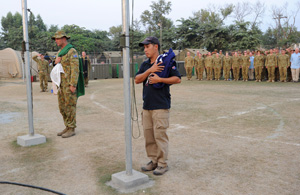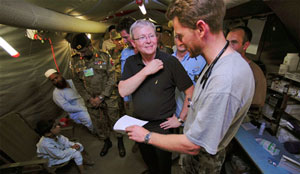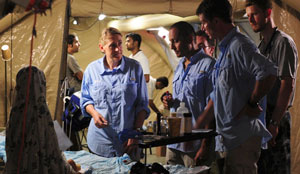Updated February 2011
Australia's Pakistan flood relief totals $75 million
In late July 2010 monsoon rains struck Pakistan causing devastating floods in the north and south of the country. The floods affected about half of Pakistan's 145 districts, or an area equivalent to the size of England. The main provinces affected were Punjab, Sindh and Khyber-Pakhtunkhwa. In response to the floods, Australia mobilised relief flights which provided emergency supplies such as family tents, tarpaulins, generators, water storage containers and birthing kits. Australia also established a medical facility in Kot Addu, Punjab, staffed by civilian and Australian Defence Force personnel, between September and October 2010. In addition, Australia provided AUD75 million to humanitarian and early recovery assistance.
Scale of the disaster
The 2010 floods in Pakistan:
- affected more than 20 million people
- killed 1,980 people
- injured 2,946 people
- damaged 1.7 million houses (913,207 houses completely destroyed)
- covered over 100,000 square kilometres of land, with 78 districts affected
- damaged agriculture, fisheries and livestock estimated at over USD5 billion
- destroyed 2.1 million hectares of standing crops and destroyed one million tons of food and seed stocks
- had a total direct and indirect damage of approximately USD10 billion.
Six months after the flooding commenced, parts of the southern province of Sindh were still under water. As at the start of 2011, round 600,000 people remained displaced from their homes in Sindh and Balochistan.
Australian funding
Australia has committed AUD75 million to meet ongoing humanitarian and early recovery needs, making us one of the largest bilateral donors to the floods. AUD50 million has been directed to humanitarian relief activities and AUD25 million supports early recovery activities in education, agriculture and health.
Australia's early recovery package is strongly aligned with the activities outlined in the United Nations and the Government of Pakistan's (GoP) revised Pakistan Flood Emergency Response Plan which was released by the Government of Pakistan on 5 November 2010. Australia's package of early recovery activities was planned in consultation with the GoP's National Disaster Management Authority, as well as with key donors.
Recognising the huge efforts required to re-build Pakistan, Australia has ensured that its response is consistent with goals to address the longer-term economic and security challenges faced by Pakistan.
Australian assistance includes support to:
- International NGOs–for example, support to the World Food Programme (WFP) for the provision of emergency food, logistics and telecommunications support to feed the estimated 10 million people dependent on food aid in affected provinces.
- Red Cross and Red Crescent Movement to support health activities, emergency shelter, food, the deployments of Australian experts and the distribution of non-food items in line with their role as auxiliary to government for humanitarian services.
- Since July 2010, the Red Cross/Red Crescent Movement has assisted the Pakistan Red Crescent assist over one million people.
- Australian NGOs–support to ActionAid Australia, CARE Australia, Oxfam Australia, Save the Children, World Vision Australia, Act for Peace, Plan Australia and CARITAS Australia for relief and early recovery activities across Punjab, Sindh, Kyber-Paktunkhwa and Baluchistan provinces, reaching over 1.12 million intended beneficiaries
- Early recovery support for activities aimed at addressing food insecurity, re-establishing livelihoods, shelter and education
- The Australia Medical Task Force (AMTF), an inter-agency collaboration between AusAID and the Australian Defence Force was established as part of the flood response.
A full breakdown of Australia's package of assistance can be found at Pakistan flood relief funding.
Achievements so far from relief and early recovery assistance include:
- Australia's support has helped to provide urgently needed emergency food supplies, essential health services, clean drinking water, shelter and protection for vulnerable persons. Australian funds have supported the provision of:
- food, shelter, blankets and cookware to over 200,000 people and the distribution of health and sanitation assistance to almost 50,000 people, by Caritas International
- water and sanitation services to 670,333 people and distribution of 358,465 tarpaulins and 66,882 shelter kits to communities displaced by the floods, by the Red Cross/Red Crescent Movement
- emergency shelter, essential household items, hygiene kits and mosquito bed nets to prevent dengue fever and malaria, to around 24,480 people in Punjab and Dera Ismail Khan district in Khyber-Pakhtunkhwa, by Save the Children International.
- Australia also established the joint civilian-military medical facility in Kot Addu, Punjab, directly responding to the Pakistan Government's request to help relieve the immediate burden of the floods on local medical services. During its seven weeks of operation, the AMTF was able to relieve the strain on government hospitals and clinics and provide medical assistance to over 11,000 flood victims in one of the country's worst-affected areas, including treatment of 2,480 confirmed or suspected cases of malaria, 894 cases of diarrhoea, 485 cases of acute respiratory infection and 169 pregnant women.
More information
- Fact sheet on 2010 floods in Pakistan (Feb 2011) [word 556kb]
-
Fact sheet on 2010 floods in Pakistan (Feb 2011) [PDF 152kb]
- Pakistan flood relief funding
- How you can help
- Download audio files, video and footage of the Medical Task Force in Pakistan and Australia's relief effort
- National Disaster Management Authority, Pakistan [external website]
- General information on Pakistan
- UN report on donations
Minister for Foreign Affairs
External website:
- Australian Medical Task Force completes initial aid mission in Pakistan (23 October 2010)
- Statement by the Foreign Minister to the UN High Level Meeting on the Pakistan flood emergency, New York (19 September 2010)
- Joint press conference transcript: Pakistan Foreign Minister Qureshi, Foreign Minister Rudd and US Special Representative for Afghanistan and Pakistan Richard Holbrooke (16 September 2010)
- Australia's Pakistan flood relief now totals $75 million (17 September 2010)
- Minister's press conference transcript (15 September 2010)
- Civilian medical personnel deployed to Pakistan (31 August 2010)
- Australian medical help arrives in Pakistan (25 August 2010)
- Australian Government deploys medical task force to Pakistan (22 August 2010)
- Transcript of interview on Radio National (17 August 2010)
- Australia commits an additional $24 million to Pakistan flood relief (17 August 2010)
-
Minister's statement on Pakistan (13 August 2010)
- Further Australian assistance for Pakistan (7 August 2010)
- Australian assistance to Pakistan following devastating floods (2 August 2010)




